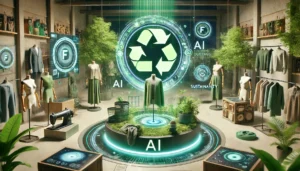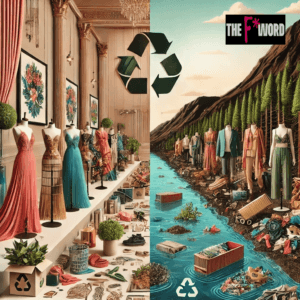The future of fashion is here, and it’s green. Digital fashion’s green revolution is transforming the industry by offering sustainable and innovative solutions.
Digital fashion is a game-changer with the power to revolutionize the industry. Let’s dive into one of its biggest perks: a smaller environmental footprint.
Fashion’s Dirty Little Secret
Behind the glam of Fashion Weeks and glossy magazines lurks a harsh reality: fashion is the world’s second-largest industrial polluter. Toxic dyes turn rivers into chemical streams, and the industry’s massive carbon footprint is suffocating the planet.
This industry is responsible for 10% of annual global carbon emissions – more than all shipping and flights combined. On top of that, fashion uses 4% of all global freshwater withdrawal annually and each second, a garbage truck’s worth of textiles is added to landfill or burned.
Fast fashion is the main culprit of such waste and damage, fueled by consumers’ habit of treating clothes like disposable items instead of durable goods. Our constant demand for cheap, mass-produced fashion has pushed the industry to overproduce and globalize, adding shipping carbon emissions as well.
Digital Fashion’s Green Revolution: A Breath of Fresh Air
Digital fashion’s green revolution minimizes environmental harm by cutting resource use and eliminating wasteful production practices. Digital fashion is shaking things up by offering a greener alternative. New tech like 3D fashion design software and virtual fashion shows are creating ways to experience fashion at a lower ecological cost.
Here’s how digital fashion is leading the charge:
- Minimal Resources, Maximum Impact: Digital garments don’t need raw materials, toxic dyes, or excessive water. Made of pixels and code, virtual clothes cut down resource use and waste. Designers craft stunning pieces with fashion design software, without physical samples, retail space or large inventories. For manufacturing, 3D fashion models allow showcasing and selling items effectively, enabling production based on demand.
- Zero-Emission Fashion: Say goodbye to shipping containers and airfreight. A virtual garment’s transport carbon footprint is practically zero.
- Bye-Bye Overconsumption: Digital wardrobes let you experiment without the ecological consequences. Try before you buy with virtual try-ons, and you’re less likely to impulse buy. Instead, you’ll invest in pieces you love, reducing waste and fostering a more thoughtful relationship with fashion.
Is It All Sunshine?
Digital fashion is not without its challenges. It relies on computing power, which uses energy. Plus, some blockchain technologies behind fashion NFT collections can be energy hogs. But as tech evolves, with more efficient algorithms and a push for renewable energy, the benefits of digital fashion will only grow.
The current outlook? Pretty promising. Studies show that digital fashion’s environmental perks outweigh its downsides compared to the devastation caused by fast fashion. And with the rise of digital fashion NFTs and sustainable tech, the future is looking greener than ever.
The Road Ahead for Digital Fashion’s Green Revolution
As digital fashion’s green revolution progresses, hyper-realistic garments and on-demand manufacturing will reshape the industry’s ecological impact. Here’s a peek at what’s next:
- Hyper-Realistic Digital Garments: Imagine virtual clothes with textures so real they rival physical ones. As digital fashion gets even more lifelike, its adoption will soar, especially with advancements in 3D design and AR.
- Recycling Meets Digital: Combine sustainable fabrics with digital prototyping, and you get waste reduction. Designers can experiment with patterns using fashion design software, without sacrificing resources.
- Fashion for All: Digital fashion should be accessible to everyone. That means user-friendly apps and platforms that anyone can use, no matter their income or tech skills. Startups like The F* Word are leading this charge.
- On-Demand Manufacturing: Digital garments can be manufactured based on demand, wiping out overproduction and cutting fashion’s footprint further, with 3D models showcasing, AR try-ons and virtual runway shows leading the charge.
What else do you think we could do to promote sustainability in fashion?



